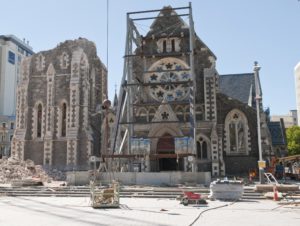Por Michael Stewart, Director coral y organista
Para un pequeño país cada vez más secularizado, Nueva Zelanda posee una vigorosa escena musical litúrgica. Esta se centra particularmente en las catedrales anglicanas en los cuatro centros principales y en algunas notables iglesias parroquiales. El propósito de este artículo es proporcionar los antecedentes generales de esta faceta de la música coral neozelandesa.
El 22 de febrero de 2011, la ciudad sureña de Christchurch fue golpeada por un terremoto de magnitud 6,3 que ocasionó grandes daños y mató a 181 personas. Seis meses antes, la ciudad había sufrido otro terremoto de magnitud 7,1 que, a pesar de que milagrosamente no causó pérdidas directas de vidas humanas, debilitó en forma significativa las edificaciones. Imágenes del terremoto de febrero han sido transmitidas a todo el mundo, y una de las más dolorosas es la de la ruinosa Catedral de Christchurch, el ícono de la ciudad en la Plaza Catedral.

La Catedral de Christchurch provee un punto de partida apropiado para esta investigación sobre la música litúrgica en Nueva Zelanda, ya que su programa musical permanente es el más similar al modelo de coro de catedral anglicano británico. Con los servicios de la catedral trasplantados a la cercana capilla del Christ College, el director musical Brian Law dirige el único coro masculino profesional de Nueva Zelanda, uno de los dos de su tipo en el hemisferio austral[1]. No es coincidencia que este programa haya echado raíces en Christchurch ya que se trata de una ciudad particularmente orgullosa de su herencia inglesa. De hecho, Christchurch fue fundada específicamente como una sociedad inglesa modelo por egresados de la Universidad de Christ Church, Oxford; un intercambio coral recíproco ha tenido lugar entre estos dos coros catedralicios durante los últimos doce años. Antes del terremoto, el Coro de la Catedral de Christchurch estaba formado por 16 jóvenes que poseían becas en la cercana Escuela Primaria de Cathedral, y 12 hombres que ocupaban puestos de cantantes profesionales de catedral. El coro floreció bajo la dirección de Law, quien lo llevó de gira por el Reino Unido en 2008. Existen planes para reconstruir la dañada catedral pero es imposible adivinar a estas alturas exactamente cuándo se realizará y cuánto durará la reconstrucción.
Siendo la herencia colonial neozelandesa predominantemente inglesa, la Iglesia Anglicana ha sido siempre la denominación religiosa más importante del país. Las siete catedrales anglicanas restantes se encuentran en Auckland (Holy Trinity), Hamilton (St Peter’s), Napier (St John’s), New Plymouth (St Mary’s), Wellington (St Paul’s), Nelson (Christ Church) y Dunedin (St Paul’s). De estas, las de Auckland, Wellington y Dunedin mantienen un programa similar al de la Catedral de Christchurch. 2011 ha sido un año interesante para estas cuatro catedrales, pues mientras Christchurch ha tenido que lidiar con los efectos del terremoto, las otras tres han designado recientemente o están en proceso de designar a nuevos directores musicales.
Ubicada en posición directamente opuesta a los Edificios del Parlamento en la capital de la nación, la Catedral de Wellington de St. Paul es utilizada a menudo para eventos de Estado y servicios de emisión televisiva. El Coro de la Catedral de 30 poderosas voces mixtas ha desarrollado la reputación de ser uno de los mejores coros de su tipo en Australasia y puede ser escuchado en vivo además de su programa litúrgico regular. También realizó una exitosa gira en el Reino Unido y Francia en 2008 bajo el liderazgo del director musical anterior, Michael Fulcher. Los Cantores de Catedral son un coro de hasta 30 niños y niñas de entre 8 a 15 años de edad que cantan con el Coro de la Catedral y están también involucrados en las orquestas regionales y nacionales con sede en Wellington para conciertos, como cuando formaron la médula espinal del Knabenchor para una interpretación de la 8va Sinfonía de Mahler bajo la batuta de Vladimir Ashkenazy en el Festival Internacional de las Artes de Nueva Zelanda 2010.
Otro magnifico monumento que padeció el terremoto de febrero fue la Catedral del Bendito Sacramento. Esta espléndida basílica era el mejor ejemplo de las muchas iglesias católicas romanas diseñadas por el arquitecto neozelandés Francis Petre. Otra catedral diseñada por Petre es la Catedral Metropolitana del Sagrado Corazón, de Wellington, una de las dos iglesias católicas de Nueva Zelanda que mantienen un programa de canto gregoriano y polifonía renacentista. La otra, también en Wellington, es la Iglesia de Sta. María de los Ángeles. La distinguida historia coral de esta iglesia se remonta al liderazgo de Maxwell Fernie (1910-1999), un director y organista nacido en Wellington que dirigió durante cinco años la música de la Catedral de Westminster. Al regresar a su país natal en 1958 asumió la directiva de Santa María de los Ángeles e instituyó el programa de música católica tradicional que aún perdura hoy en día.
Aunque existen muchas iglesias parroquiales en Nueva Zelanda que no poseen un programa coral regular, hay algunas excepciones notables. Las provincias más australes de Otago y Southland atrajeron originalmente a colonos escoceses, y como resultado la Iglesia Presbiteriana ha continuado floreciendo ahí, particularmente en la Iglesia Knox en Dunedin que mantiene una orgullosa tradición de música coral. Otros coros parroquiales destacados del país incluyen a la Iglesia Anglicana de Todos los Santos en Palmerston North y la Iglesia Anglicana de St. Mark en Auckland.
Los coros eclesiásticos de Nueva Zelanda reciben el apoyo de la sucursal neozelandesa de la Música Eclesiástica del Royal School (RSCM por sus siglas en inglés). La RSCM dirige una escuela coral de Verano e Invierno todos los años, el último consagrado exclusivamente a niños y adolescentes. Músicos eclesiásticos de renombre internacional son solicitados para liderar la Escuela de Verano cada año; el curso anterior en enero fue encabezado por Timothy Noon (ex director de música en la Catedral Metropolitana de Liverpool) quien ocupará en septiembre el puesto de director musical en la Catedral de la Sagrada Trinidad en Auckland. El esquema de formación de la RSCM, ‘Voces por la vida’ es utilizado extensamente en todo el país como un medio para educar a jóvenes cantantes en teoría y producción vocal.
En cuanto a componer para la iglesia, Shirley Murray es quizás nuestra compositora de himnos más célebre, cuyos textos aparecen en más de 100 colecciones en todo el mundo. Murray ha sido homenajeada como miembro de la Música Eclesiástica de la Royal School (2006) y fue nombrada miembro de la Sociedad de Himnos en los Estados Unidos y Canadá en 2009. Las catedrales de Nueva Zelanda siempre han fomentado la composición de música nueva, particularmente Richard Madden en Dunedin, y Katherine Dienes-Williams (ahora organistas y maestra de Cantores en la Catedral Guildford) en Wellington. Luego de un período fructífero como compositor residente en la Catedral de Wellington de St. Paul, el joven compositor Andrew Baldwin ha producido numerosas obras altamente efectivas que constituyen un buen presagio para el futuro.
[1] Siendo la otra la Catedral de St. Andrew en Sydney, Australia.
 Michael Stewart está al frente de una generación más joven de directores corales en Nueva Zelanda, así como uno de los principales organistas concertistas del país. En junio de 2011 fue nombrado organista y director musical de la Catedral de Wellington de St. Paul, luego de servir previamente por cinco años como director musical de la Catedral Metropolitana del Sagrado Corazón. Michael es también el director musical de The Tudor Consort, miembro del equipo artístico de los Coros Aotearoa de Nueva Zelanda y miembro del Coro de Cámara de Voices New Zealand. Posee el título de Licenciado en Música con honores de la Universidad de Canterbury y una Maestría en Música con especialización en interpretación de órgano de la Universidad de McGill (Montreal, Canadá). Ha grabado como organista y como director para Canadian Broadcasting Corporation and Radio New Zealand Concert y ha producido dos CDs solistas de órgano: Puissant (2001) y Ave Maris Stella (2007). E-mail: mrjstewart@gmail.com
Michael Stewart está al frente de una generación más joven de directores corales en Nueva Zelanda, así como uno de los principales organistas concertistas del país. En junio de 2011 fue nombrado organista y director musical de la Catedral de Wellington de St. Paul, luego de servir previamente por cinco años como director musical de la Catedral Metropolitana del Sagrado Corazón. Michael es también el director musical de The Tudor Consort, miembro del equipo artístico de los Coros Aotearoa de Nueva Zelanda y miembro del Coro de Cámara de Voices New Zealand. Posee el título de Licenciado en Música con honores de la Universidad de Canterbury y una Maestría en Música con especialización en interpretación de órgano de la Universidad de McGill (Montreal, Canadá). Ha grabado como organista y como director para Canadian Broadcasting Corporation and Radio New Zealand Concert y ha producido dos CDs solistas de órgano: Puissant (2001) y Ave Maris Stella (2007). E-mail: mrjstewart@gmail.com
Traducción del ingles por Diana Ho, Venezuela
Edited by Irene Auerbach, England

